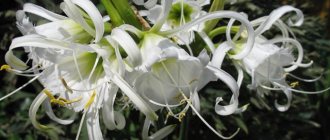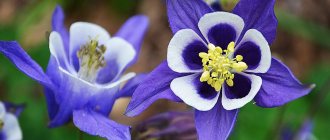Brief botanical description
Sparaxis (lat. Sparaxis) refers to bulbous deciduous plants; the genus includes 15 species of perennials. Fleshy, lanceolate-shaped leaves reach a length of 90-100 cm, forming a spikelet at the top.
The maximum height of peduncles is 60 cm, and to achieve spectacular group flowering, the bulbs need to be planted almost close to each other.
Sparaxis blooms in May and June - during this period the plant throws out a fairly powerful peduncle, on which there are star-shaped buds up to 5 cm in diameter, with a pistil in the middle.
The color of the flowers is characteristic - orange, yellowish, white or cream petals are separated from a bright yellow center by a dark ring. Sparaxis dries up at the end of August or early September, shedding its foliage and leaving only the underground part.
Only two types of sparkasis are used for cultural cultivation: tricolor (Sparaxis tricolor) and graceful (Sparaxis elegans).
There are about 20 varieties in total, with the most popular being “Jumbo Star Mix”, “Bilbifera”, “Tricolor Mix” and “Grandiflora”.
They look spectacular not only in the photo - in flower beds, sparaxis instantly attract attention with their bright inflorescences.
Types and varieties of Sparaxis
Decorative types of sparaxis are just beginning to gain popularity in the European part of Russia. The basis for selection was only 4 species out of 20 known in nature. From them it was possible to obtain a varied palette, which varies from white to deep purple, with a characteristic tricolor color of the perianths.
Cultivated sparaxis do not have any special varietal differences, with the exception of some characteristics.
Sparaxis Graceful - up to 15 cm high. However, its small height is skillfully used by designers not only to decorate park areas, but also in the interior of a home. The petals of this species have a more rounded shape.
The second “ancestor” is Sparaxis Tricolor , characterized by a higher height of stems and leaves - up to 60 cm, and a more elongated shape of the perianth.
Sparaxis Bilbifera can be distinguished into a separate group , with narrow and ribbed leaves, like daffodils, less variegated color of the petals, in white and yellow pastel colors.
Finally, Grandiflora is a fragrant sparaxis, which quickly gained popularity thanks to its delicate and refined aroma combined with the graceful shape of the inflorescences.
Sparaxis tricolor (Tricolor)
The variety attracts attention with its bright combination of red, black and yellow colors. The pistil and stigma are framed by the yellow base of the petals. The yellow line of the funnel with the edges of the petals is sharply demarcated by a violet-black wide outline in the middle. Other species are no less beautiful, with coral, white, pink petals, also having a tricolor color.
Each peduncle has 5-7 buds, which bloom alternately, which increases the duration of flowering. Large, bright flowers (up to 5 cm in diameter) look impressive against the background of bright green sword-shaped leaves.
Bilbifer's sparaxis
The most unpretentious variety, tall. Even in temperate climate zones it blooms earlier than other sparaxis. The height of the stems is up to 60 cm, the leaves are 40-50 cm. The diameter of the flower is 6 cm. The narrow oblong petals of the perianth are uniform in color, have a lemon-yellow color at the base, and do not fit tightly to each other, like other cultivated plant species. . In group plantings they create an openwork pattern. The white sparaxis of Bilbifer looks especially tender. Available in yellow and vanilla varieties.
The Bilbifera variety is ideal for creating a monochrome garden in yellow or white tones.
Attention! Sparaxis of this species prefers sandy soils with neutral acidity. Before planting the bulbs in the beds, you need to add slaked lime in advance.
Sparaxis Grandiflora
Gardeners who are accustomed to not only admiring the blooming garden, but also inhaling the unique aroma of flowers, will like the Grandiflora variety, which is called fragrant. Large flowers with oblong petals have a delicate, refined aroma. The narrow and thin plates of the bract merge with the color of the petals, which creates the visual effect of long, half-opened inflorescences and gives the sparaxis of Grandiflora additional grace.
On each of the peduncle stems, 3-5 inflorescences are formed. Varieties are known in white, yellow and purple colors. With proper care it blooms profusely and for a long time.
Sparaxis Lord of Fire
The petals of this variety look like the attractive flame of a night fire. Sparaxis Lord of Fire comes in two varieties. In one, the edges of the petals are bright red, and in the other, in addition to yellow and black, crimson stripes alternate with white. The flowers are large, with wide cone-shaped petals. The variety is called “striped” because of the characteristic pattern on the petals.
Sparaxis Moonlight
The shape of the flowers of Sparaxis Moonlight is similar to Grandiflora, but smaller. During the period of mass flowering, the flowerbed turns into a pastel lilac color, as if shrouded in a white haze. The color is complemented by bright crimson longitudinal strokes on the petals. In the yellow funnel inside the bract there is another contrast, from dark purple stamens.
Sparaxis Sunny day
Pastel yellow tones with blurred borders at the base, fuzzy dark strokes - sparaxis Sunny day. The shape and size of a flower with the Moonlight variety. But the inflorescences bloom together. During the Sunny Day season, it produces 2-3 flower stalks.
Sparaxis Graceful
A low-growing plant with an original combination of orange tones at the upper edge of the petals with a pink funnel at the base, turning into lilac-violet shades with a sharply defined outline of a dark color. In the center are large stamens and pistil in dark lilac tones. The height of the sparaxis is 15 cm. There are dwarf species of different colors. They are used for planting along borders, in rockeries, in combination with tall sparaxis and other bulbous plants.
Planting sparaxis in open ground
It is best to grow sparaxis in the southern regions, the climate of which is as close as possible to the natural environment where the crop grows.
Mild and warm winters, hot summers and late autumn create suitable temperatures in which the plant develops successfully. In the south, bulbs are planted before winter, in the last ten days of October, and overwinter well in flower beds, sprinkled with a layer of sawdust.
The mulch is removed immediately after the snow melts to avoid overheating of the plants, and the flowerbed itself is fertilized with humus, scattering it over the surface of the soil.
Planting in areas of the middle zone is also allowed, but here the bulbs must be dug up for the winter and then transferred to open ground in the spring.
The approximate planting time is the end of March, when the soil warms up well. At the same time, be sure to take into account the climate and weather conditions while waiting for stable heat.
When planting sparaxis in open ground, it is necessary to take into account several recommendations:
- The area chosen for cultivation should be well lit by the sun, but not blown by winds or drafts.
- The optimal soil is nutritious loam, but planting in other soils is also allowed, provided there is good drainage.
- The depth of the hole should be 5-6 cm, the distance between the holes should be 8-10 cm, and the row spacing should be the same width. For low-growing varieties, the step can be shortened slightly.
- Watering after planting is required - this is necessary for successful rooting.
Bulbs transferred to open ground require careful care - this will not only preserve the health of the sparaxis, but also guarantee good flowering.
How to grow sparaxis from seeds?
Sparaxis is a rather demanding plant; growing it requires gardening experience and dexterity. Seedlings are first grown in deep boxes with light, fertile soil. The plant prefers a warm and humid climate, so the crops are kept in a greenhouse or similar conditions.
The seeds are placed in the soil to a depth of 5-10 mm and covered with film until the first shoots appear. Young plants are immediately thinned out to achieve a distance of at least 2 cm. Seedlings are regularly watered and kept in a lighted place. When they reach a height of about 6-8 cm, the seedlings can be transplanted into open ground. The plant is very sensitive to cold, so it is important that the danger of frost has passed.
In a permanent place between flowers there should be a distance of 15 cm (when growing for cutting) or 45 cm (when decorating the garden). In the first year after sowing, flowering is usually not expected; the plant takes root and grows green mass.
Sparaxis: care at home
Conditions close to tropical and constant care are the key to successful cultivation of sparaxis in a personal plot.
Agricultural technology comes down to several main points:
Good lighting
The sunny side is preferable, since the slightest shading reduces the intensity of flowering of the crop. Neighborhood next to tall plants, trees, bushes and buildings is undesirable;
Abundant and regular watering
Sparaxis is characterized by rapid and active growth, during which it requires constant hydration. Use settled water, heated in the sun; it is better to water it early in the morning or in the evening, avoiding dripping on parts of the plant.
The frequency of soil moistening is at least 2-3 times a week in dry spring and hot summer.
Spraying
A moisture-loving tropical plant in extreme heat needs spraying to increase the air humidity around the outlet.
The optimal time for this procedure is morning or evening (as with watering), since under the rays of the sun, drops accumulated on the leaves can cause burns.
Feeding
Growing sparaxis in open ground is impossible without periodic application of fertilizers.
It is recommended to use special formulations for bulbous plants, adding them to the soil along with water for irrigation once a month. In the fall, feeding is stopped so that the bulbs go to sleep.
Important: when grown in high-quality and nutritious soil, sparaxis does not need fertilizing; average and depleted soils are fertilized according to the above scheme. The last feeding occurs at the peak of flowering.
To form new shoots, you need to remove old leaves and dried inflorescences regularly. In addition, periodic “cleaning” will have a positive effect on the nutrition of the bulb - dead parts will not draw juices out of it.
When and how to plant
Those who have already dealt with gladioli will find many similarities between these representatives of the flora. Considering what features the hero of this article has, planting sparaxis is most easily done using bulbs. You can buy them, or get them yourself.
To do this, when the time of autumn comes and flowering comes to an end, the bulb is dug up. By that time it had already been divided into several fragments. They are very carefully separated from each other. Here are the preparations for the future garden.
Initially, you need to let them dry. This will take five days. So that they retain their vitality, they cannot be left anywhere. Since these “embryos” will have to wait in the wings until spring, it is necessary to create suitable conditions for them.
Firstly, temperature. It should not be hot - maximum +10. But it’s not cold either, so look for suitable places in the house, it could be the cellar. Secondly, take care of the constant flow of fresh air into the room, ventilate it.
And finally, you can’t just lay them out on the floor; you need some kind of substrate. Sawdust is quite suitable for these purposes. If you did everything correctly, you don’t have to worry, the planting material will retain its properties for up to three years.
When spring is around the corner, the sparaxis bulbs must survive the move. To begin with, bring them to where it is warmer, and significantly. Average room temperature in a living space is fine. The tubers should spend a couple of weeks in the new place.
Afterwards, you need to decide where you will plant - in a pot, or directly outside. But in any case, you need the right mixture for this. The set of components will be as follows: loam plus sand (the ratio should be 50/50), plus some kind of organic fertilizer.
Compost can serve as the latter; humus will also work. In addition, a prerequisite is a drainage layer. Make sure it is at least five centimeters thick.
Both expanded clay and ordinary gravel will work here. The hole should be small, only ten centimeters deep, but the distance between the planted tubers needs to be twice as large.
If we talk about when to plant sparaxis, then you also need to remember that this flower is heat-loving, therefore, if you do not live in the warmest latitudes of our country, do it in March.
Then at the height of summer you will be pleased with the bright inflorescences. If the climate in your region is mild, you can plant in the fall. Then, already in May you can count on flower beds pleasing to the eye. And by mid-summer such buds will fade. The main thing to remember here is that if the temperature drops below zero, the matter is lost, the tubers will die.
When you want, you can resort to another way to acquire such beauty in your garden - buy seeds. But get ready, it won't be that simple. If you at least allow the temperature to drop, you can say goodbye to this idea.
To begin, take a box or a special flowerpot. The container must be filled with suitable soil. The seeds do not need to be deepened too much; a centimeter will be enough; you can lower them into the ground to a shallower depth.
Next, you need to wrap all this equipment in film and leave it alone for a while, but only where it is warm. Do not forget about moisture, it must be supplied in sufficient quantity. Have you noticed the first shoots? – take care of thinning immediately.
Provide a distance of two centimeters between plants. The next step is to wait until the seedlings reach a height of eight centimeters. Watering and sunlight should be provided at this time. When the plants reach the desired size, you can move them to their permanent location. But remember that after transplantation, no frost.
These flowers look best in a group. Therefore, you should not scatter plants individually throughout the garden. Arrange a whole “island” of colorful inflorescences. If we are talking about very long varieties, then take a reserve of 10 centimeters when planting; you should not plant them closer.
If you like plants that are not so tall, then four centimeters will be enough. But there should be no trees nearby that will create shadow, because your flowers need more warmth and light.
Storage and wintering of bulbs
Corms are sensitive to any temperature changes and do not tolerate cold well, so they need special wintering conditions.
Before storage, planting material must be prepared:
- In the fall, dig up along with the above-ground part and carefully clear away the soil;
- Place in a dry and well-ventilated area to dry;
- When the above-ground part has completely withered and dried out, it must be separated from the bulb;
- The bulbs are stored in sawdust or straw at a stable temperature within +5-+9 degrees and in complete darkness.
During wintering, the bulbs should be periodically inspected, removing all rotten or dried specimens.
Before planting in open ground with the onset of spring, the box is transferred to a warm room (+25-+27 degrees) for awakening. This approach promotes rapid rooting and active growth.
Important: if babies have formed on the mother bulb, they are separated immediately before planting in open ground.
If optimal wintering conditions are created, sparaxis can be stored for 2-3 years without planting in a flower bed. It is important to avoid critical humidity levels - both excessive humidity and dry air are detrimental to the bulbs.
Description and features
What's the first thing that changes when spring comes? Of course, it's getting warm, but we're not talking about the weather now. Everyone wants bright colors. After all, greenery and bright buds have not pleased us with their appearance for at least six months.
Gardeners are starting to revive their garden after winter hibernation. But in order for it to bloom, you will have to wait another month. However, there are some plants that can be called “early birds.” Among them is sparaxis . This small flower will fill the garden with bright color even before summer arrives.
The buds bloom already in the spring months. True, not all climatic conditions are appropriate here. Initially, such garden decoration could only be found on the African continent. These “flower beds” went along the rivers. The stems can be called tall, because they reach a hundred centimeters in height. But, this is only in Africa, or where the climate is similar.
Now the plants have taken root in our country. Only they gained the greatest popularity among residents of the south. This is understandable; in the north, a flower either will not survive at all, or will force its owner to sweat a lot in order to maintain the appearance of a “pet”. You are unlikely to be able to grow meter tall plants, but half a meter high is fine.
Traditionally, corms are very popular, because they can be called perennials. This very bulb will produce a “harvest” year after year. sparaxis flower also belongs to this group . It is also related to the iris family.
In appearance it is an inflorescence of small petals, each of which is two-colored. Moreover, these colors are contrasting, which only adds to the beauty. It can be all shades of sunny yellow, scarlet, purple, or white.
Together they form either a completely flat circle, or slightly raised and resemble a funnel. If measured, the diameter reaches five centimeters. In the center of this entire composition is a pestle. It is kept company by stamens, of which there are three.
The leaves are similar to sedge, they are oblong with pointed ends. Together with unusual pointed leaves, this creates an original composition. She will get along quite well with the other “residents” of your garden. To prevent these bright “stars” from getting lost in the ensemble, keep in mind that it is better to plant them in the foreground.
It is better not to limit yourself to one flower, but to collect about a hundred stems in one place at once. Then the desired effect of a bright and exotic garden will definitely be achieved. Such a garden dweller will look great in a hanging flower pot. Florists also fell in love with this African representative. Cut specimens show their positive side in bouquets; they last a long time.
Reproduction of sparaxis
The bulbous plant can be propagated at home by seeds and corms. True, the option with seeds is allowed only in warm climates or when planting in a greenhouse, since seedlings must be preserved without digging for 2 years until flowering.
Seeds are sown in ordinary pots or in seedling beds in August. They need to be germinated warmly in a nutritious, loose substrate. After the emergence of seedlings, thinning is carried out. After strengthening the young shoots, they are transferred to greenhouses or open ground.
Use in landscape design
Small, colorful sparaxis flowers look great in group plantings. In landscape design, the plant is used:
- in combination with ground cover plants - for accent spots;
- around ornamental shrubs;
- in mixborders, rockeries;
- as potted crops for home and garden plots;
- in monoflowers and with other bulbous plants.
Sparaxis lasts a long time when cut and is used for bouquets.
Despite certain growing difficulties, flower growers fell in love with the bright African. Sparaxis brings a riot of colors and exotic notes to the design of familiar flower beds. Exquisite shades and geometrically drawn details of the petals add charm and unusualness to the areas.
Diseases and pests
Despite the fact that the flower loves moisture, a constant overdose of liquid can lead to rot affecting the plants. Another ailment that can affect greenery is chlorosis. Its signs are yellowing of leaves and cessation of growth.
Iron deficiency can lead to such symptoms. To overcome the disease, arm yourself with chelate-based products. With their help, you need to treat the plant susceptible to the disease.
Gardeners are also not immune from such scourges as pests. For example, spider mites. This is where insecticides come to the rescue. You can tell whether these insects have settled on a flower by the characteristic spots; they are either light green or beige. If the pest has chosen the place for a long time, then the web is attached to all of the above.
Burrowing insects such as mole crickets can damage the bulbs. They just gnaw on the roots. To avoid this situation, set up traps for harmful bugs. These should be small holes next to the flower beds.
Place manure in these holes. True, cow milk will not be as good for these purposes as horse milk. Then all the insects will flock there like bees to honey. And when they all accumulate in one place, it will be much easier to destroy them. If suddenly this bright representative of the garden “refuses” to bloom, the reason may be a cool or too cloudy summer.
General rules of care
Note to flower growers:
- soil moisture. Water abundantly: the plant does not tolerate a lack of moisture. Do not overfill the flower: softening and rotting of all parts of the Sparaxis are possible;
- air humidity. The plant does not tolerate dry days well; it is useful to spray it in the morning and evening, especially for young flowers. Increased air humidity is beneficial, but water should not be sprayed on cold days to avoid rotting;
- priming. The tropical species does not like heavy, acidic soils in which water stagnates. Fertile but light loam is ideal. It is useful to use the same substrate as for other corms: Adding sand to the soil makes the substrate lighter and improves air permeability. Wednesday – neutral;
- illumination Which place to choose? Unshaded areas where strong winds do not blow are suitable for planting Sparaxis. You cannot plant flowers in lowlands and under deciduous trees with a dense crown;
- fertilizing and fertilizers. With good, nutritious soil rich in humus, fertilizing is not needed. If the flower is grown in a container or on poor soil, then it is useful to apply mineral fertilizers every month containing more potassium and phosphorus, and a lower percentage of nitrogen, magnesium, and other useful components.
Sparaxis is more demanding in terms of growing conditions, but even a novice gardener can enjoy the results of his work, looking at the riot of colors. You just need to pay attention to the exotic flower. If you don’t have time to carefully care for a tropical species, then it is better to plant other, less capricious plants in your dacha or near a private house, for example: Gaillardia, Morning Glory, Lobularia, Dimorphoteca, Coreopsis, Primrose.











